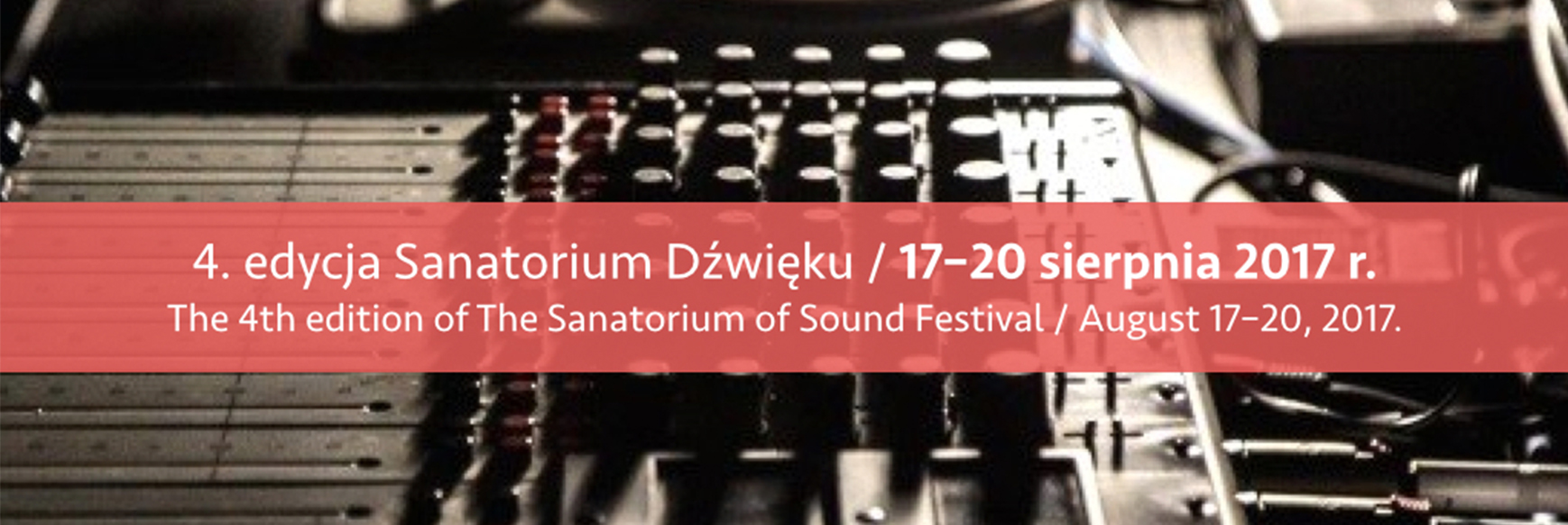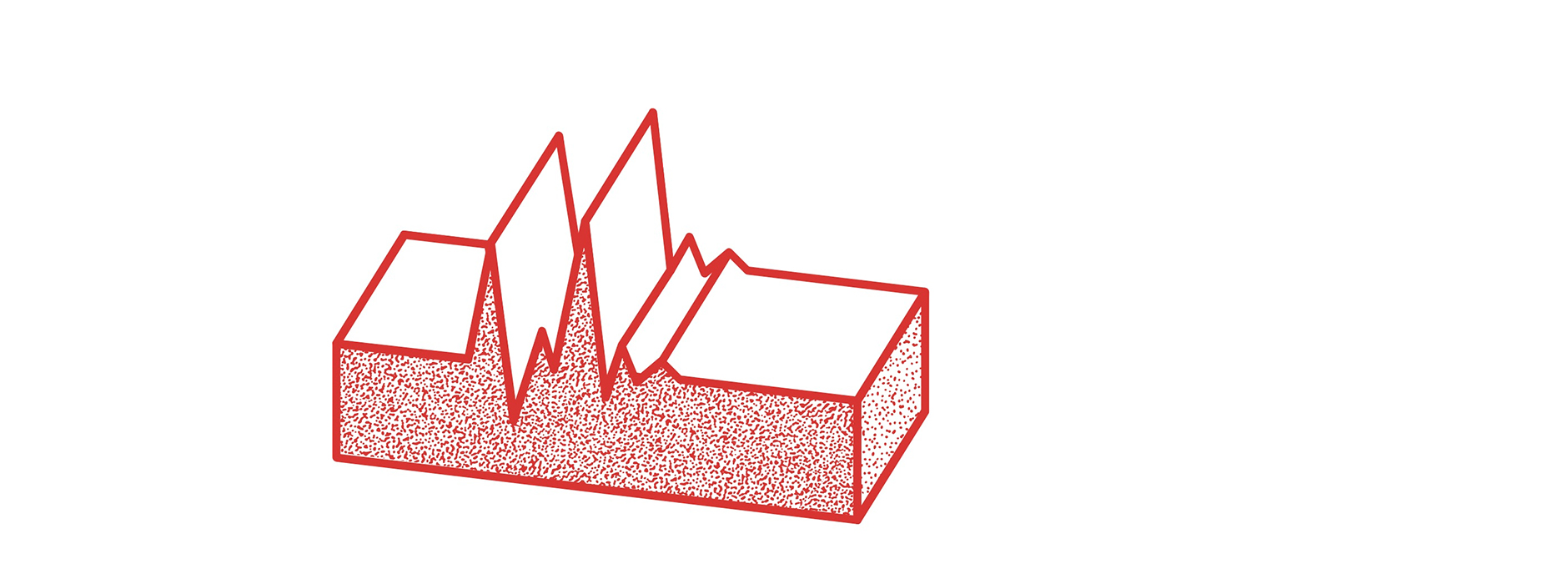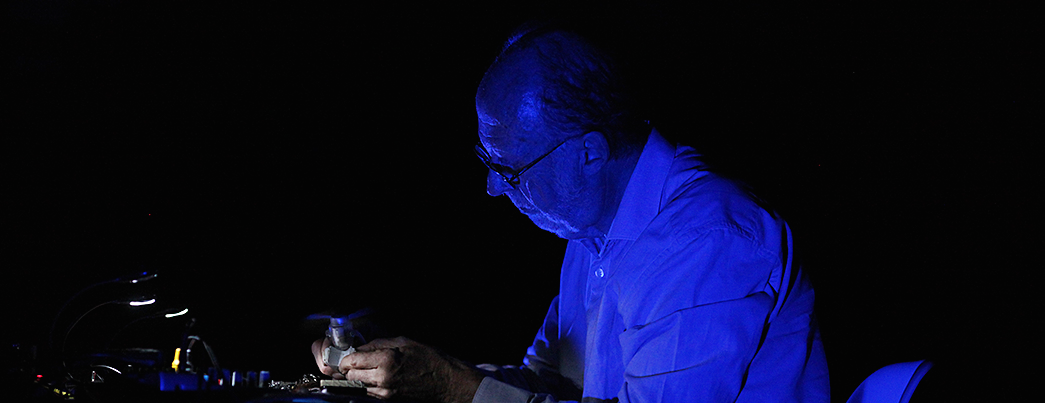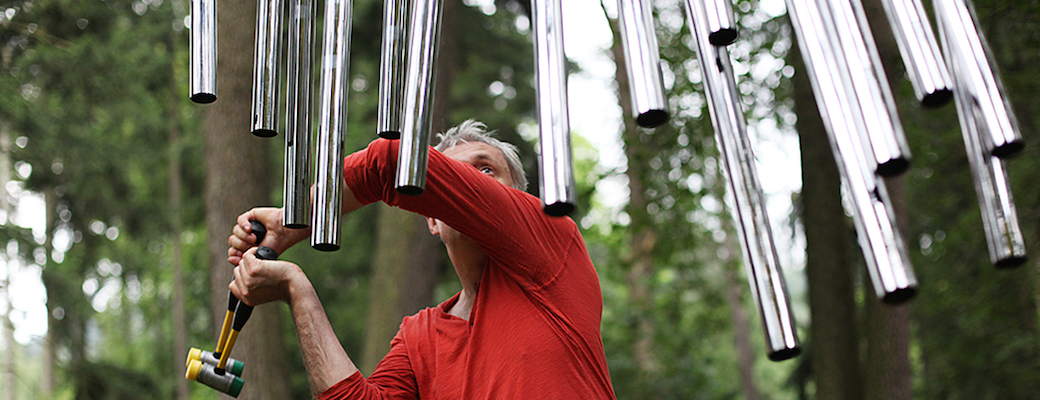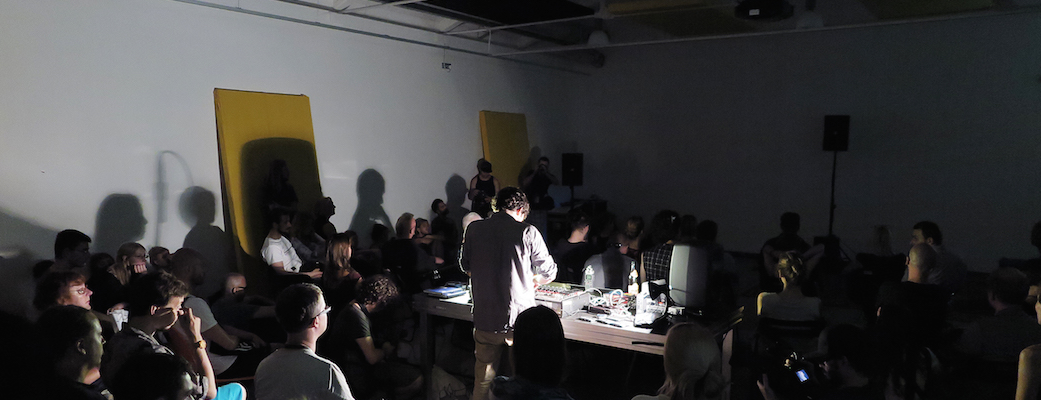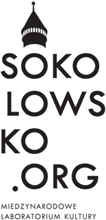15 August / MONDAY / 16.00–18.00 / Kinoteatr Zdrowie ul.Główna 36
Józef Robakowski – “The Sounds of Motion Picture” (video projection)
Józef Robakowski, photo courtesy of the artist
With the Workshop of the Film Form, he focused on an analysis of new media language, striving to rid film of “alien elements” – anecdote, literary forms, narration – and make its language simpler and information denser. From 1974, Robakowski also embraced a new medium – video art.
Born in 1939 in Poznań, he lives and works in Łódź as an academy professor and theoritician, while making films, photographic series, installations, drawings, objects, and conceptual projects.
Read about the Workshop of the Film Form (The Film Form Studio).
He studied art history in the Department of Fine Arts of the Mikołaj Kopernik University in Toruń, and cinematography at the National Higher School of Film, Television and Theatre (PWSFTviT) in Łódź. In Toruń, he was the founder of artistic collectives Oko (1960), Zero-61 (1961-1969), and Krąg (1965-1967), and member of the ‘Pętla’ Student Cine Club (1960-1966). In Łódź, he co-organised the Workshop of Film Form (from 1970), and the ‘Stacja Ł’ Television Creative Group (1991-1992). He teaches at the National Higher School of Film, Television and Theatre in Łódź.
An integral part of Robakowski’s work are his statements and self-commentaries, as well as numerous programming texts and manifestoes, e.g. Calling Once Again for ‘Pure Film'(1971), Video Art – a Chance to Approach Reality (1976), or Manipulating! (1988). Since the 1960s, Robakowski has remained an active animator of cultural life, as the author of a number of important initiatives (e.g. the Exchange Gallery), organiser and curator of exhibitions, and originator and editor of publications (Nieme Kino, Pst!).
Robakowski made his first experimental film in 1962, 6,000,000, a compilation of fragments of Holocaust-era documentaries. Photographic activity dominated the early period of his practice, also as part of the collective Zero-61 (fellow members included Czesław Kuchta, Jerzy Wardak, Andrzej Różycki, Antoni Mikołajczyk, Wojciech Bruszewski). According to Robakowski, the group drew inspiration from the “tradition of metaphorical montage known from interwar painting, photography, and avant-garde cinema.”
During that time, besides various photographic experiments (e.g. Photo-Painting, 1958-1967; double-exposure photographs employing mirror-image composition), Robakowski made photo-objects, such as Colander (1960), the photograph of a colander nailed to a plank. One of Zero-61’s most important presentations was an independent exhibition at a deserted smithy in 1969, where instead of photographs the viewer encountered ‘objects for photographing’. Between 1965-1967, Robakowski was also active on the collective Grupa Krąg, which brought together visual artists, filmmakers, poets, sculptors, and photographers. The artist remembered:
These exhibitions were like quasi-theatrical happenings, with all kinds of actions, ‘tricks’, transforming exhibition presentations into spectacles (…) I was closest to a simulated character that didn’t really exist, and its name was Józef Korbiela.
The smithy exhibition took place at a time when Robakowski was already studying in Łódź. There, in 1970, the Workshop of Film Form (Warsztat Formy Filmowej) was founded, initially within the framework of the Student Science Club of the National Film School in Łódź, active through around 1977. The Workshop’s practice, focuses on an analysis of the new media language (photography, film, video), drew its inspirations from the constructivist tradition and conceptualism, striving to get film rid of ‘alien elements’ (anecdote, literary forms, narration) and make its language simpler and information denser.
The artist’s analytical position at the time was also manifested in his interest in the peculiarities of human perception towards the still cameras and film cameras, in questions about these tools as extensions of the human organism’s mental and physiological functions. During this time, from 1974, Robakowski also embraced a new medium – video.
The move away from the traditional forms of filmic narration often went hand in hand with a rejection of the representational function. The non-camera film Test II (1971) is among the most radical statements against the narrativity and illusiveness of the traditional filmic message, made by puncturing a dark film tape, as a result of which the viewer was ‘attacked’ by a strong beam of projector light, producing the effect of afterimage. During a festival in Knokke-Heist in Belgium in 1971, Robakowski enhanced the effect by using a mirror to reflect the projector light towards the audience (Test I). Light also played an important role in many of the artist’s later works, such as 1, 2, 3, 4… (1992), or Attention: Light! (2004), made in collaboration with Wiesław Michalak, with a score by composer Paul Sharits, and music by Fryderyk Chopin.
In the 1971 manifesto Calling Once Again for ‘Pure Film’, the artist wrote,
Currently the subject of my work is eliminating from film elements characteristic for literature. I am aware that such a conception constrains my freedom of action, raises artificial barriers, and leads me to the peripheries of the genre. I believe however, or rather, am convinced, that through various kinds of experiments, trials, propositions, I will succeed in freeing film from the ballast of habits adopted from literature, uncritically accepted almost universally by both filmmakers and viewers.
The question the Workshop of Film Form artists were asking was therefore one about whether there exists a language appropriate for the film medium. The first piece made as part of WFF was Robakowski’s Market Square (1970), an animated film compiled with still images of the Łódź market square, Czerwony Rynek, made every five seconds on a single day between 7 am and 4 p.m. In the film, that time was compressed to five minutes.
An important aspect of Robakowski’s WFF work were experiments with image and sound – an extra soundtrack, asynchronicity of sound and image, or their mutual relation. The artist experimented with them in Próba II (1971), juxtaposing intense red colour with classic organ music. In Dynamic Rectangle (1971), Robakowski manually shaped a rectangle to music by Eugeniusz Rudnik. The issue of the relation between sound and image returned frequently in the artist’s oeuvre, including the films Videosongs (1992) and Videokisses(1992).
Józef Robakowski’s Own Cinema at CSW – Image Gallery
Since 1978 Robakowski has run Exchange Gallery (Galeria Wymiany), a private gallery of recent art featuring leaflets, films, videos, objects, photographs, books, posters, documentations, and all kinds of publications, both the artist’s own and donated by other artists. The guiding idea of Exchange Gallery is to ‘exchange artistic ideas, cause ferment, and stimulate creative initiatives’. In 1987, Robakowski photographed himself – or, rather, his chest – with objects from the collection, creating the Fetishes series. Exchange Gallery was also responsible for initiating a number of important artistic initiatives – exhibitions, symposiums, publications, particularly in the 1980s.
As part of the Chip-In Culture (Kultura Zrzuty) movement, Robakowski organised the Nieme Kino independent film festivals at the Strych in Łódź (1983-1985), and the Video-Art-Clip International Festival (1987-1989). In 1989, on Robakowski’s initiative, a series of everyday events and presentations took place in Łódź, called Dungeons of Manhattan, or New Media Art.
Since the 1970s, an important role has been played in Robakowski’s art by his concept of art as a field of energy transmissions. Hence he has focused in many of his works, which are often biological-mechanical recordings, on issues such as vitality or energy resulting from the contact with a tool. The film are often an effect of an encounter between the mechanical camera and the human body, a confrontation between man and medium. “I want to tell you all that art is energy”, Robakowski says, jumping out of water in his Energy Manifesto(2003), as if paraphrasing and referring to a conception by Andrzej Pawłowski, who claimed that “art is an energy field”. Robakowski wrote in 1977,
For many years I have been studying the relationship between my psychophysical organism and the devices I make mechanical recordings with (film camera, still camera, video camera, tape recorder). These studies have resulted in a sense that technological inventions are of fundamental significance, because they make it possible to convey my psychophysical states, my temperament and consciousness, to tape.
As Piotr Krajewski writes, “The artist is left alone with the camera and through it, connected with space, he follows the nature of the energy emitted by the human being, and at the same time, its traces recorded by the camera”. The best example of this may be the film Walking, made during the Workshop of Film Form period (1973), recording the artist’s climb up the stairs of a parachute tower. In the single-sequence film, growing increasingly tired, he counts off steps from one to two hundred.
In 1975, Robakowski started a series of works called Energetic Angles, which, as he says,
reflect my fascination with the problem of the existence of ‘Angles’ as a kind of intuitive geometry. (…) I’ve been wondering to what extent geometry, whose goals are intended to be purely practical, can function in art. For the problem to gain significance, I’ve decided to establish the Angles as an energetic culture sign in the form of a personal fetish.
Energy fields have also been realised in Robakowski’s art in other ways. In the 1980s, he made films based on recordings of rock concerts, especially his favourite band, the punk group Moskwa. In 1989, in the film My Videomasochisms, he mocked self-mutilating tactics of performance artists: during a for-camera performance, he manipulated various tools next to his face, inflicting a kind of torture on himself. In 1996, in a TV studio, he carried out a happening, broadcast live, during which he was connected to electricity, asking viewers to increase the voltage (I Am Electric). Most recently, in 2008, the artist introduced, as Energy Manifesto, the vastness of the Niagara Falls in the space of Galeria Atlas Sztuki in Łódź. The artist said in an interview given prior to the exhibition’s opening,
“This is to be a laboratory-like, artificial situation, but favourable for the person willing to spend time in it. The viewer’s contemplative bliss, despite the powerful audiovisual energy, is to be guaranteed by a stylistic figure I call monotony”.
In the early 1980s, Robakowski introduced yet another term explaining his practice – ‘personal cinema’, that is, one based on the observation of one’s immediate surroundings as well as ‘self-observation’. He wrote in 1981,
“So let’s keep filming everything, and it will turn out we’re always filming ourselves. Such a filmed and filming individual lives fully only on screen and while his physique is similar to yours, his character and personality are different. It is extremely interesting that you can polemicise with yourself via the screen. So keep filming and keep looking closely and critically with a sense that you on screen are more wonderful than in nature, because you are better able to remember the past. Finally, take into account the fact that your memory often becomes the viewer’s memory.”
At the time when Robakowski wrote these words, he had already begun shooting footage forFrom My Window (1978-1999), a collection of camera observations of the courtyard of the artist’s tenement in a part of Łódź known as Manhattan, recording the residents and the changes occurring in the space over the years. The film ends with images of the construction of a hotel that is to ultimately obscure the view from Robakowski’s window.
The moving video About Fingers (1982) is, in turn, a kind of biography, told for each finger separately (with the characteristic independent narrator from Robakowski’s works delivering a background monologue), and at the same time, a ‘self-observation document’, revealing the private and subjective. Patricia Grzonka notes that, given the piece’s historical context and the artist’s personal situation at the time – he had just been fired from his teaching position – About Fingers “can also be interpreted as a metaphor of the political situation of the era, a manifesto of the artist’s withdrawal at a time of his exclusion from public life”.
Of similarly private nature was My Theatre (1985), enacted for the camera by the artist’s hands and fingers, again accompanied by an off-screen monologue. During the same time, Robakowski also made films, called ‘television re-reports’, with clear allusions to the socio-political situation at hand. Brezhnev’s Funeral (1982), or Art Is Power! (1984), bringing together footage from a Soviet military parade with music by the Slovenian group Laibach.
In his later films Robakowski often reached for private, intimate stories. In Joseph’s Touch(1989), he tells about his three encounters with homosexuality in various stages in his life, with the visual background of images of a gay couple he met in Montreal. In 2004, Robakowski recorded a fictional telephone conversation with his mother, whom he congratulates on her birthday (Conversation With My Mother).
Collector
Józef Robakowski also collects contemporary art. His private collection was presented at one of the exhibitions in the Uśpiony kapitał / Sleeping capital series in the Orangerie of the Wilanów Palace and in Profile Foundation (2013).
The exhibition Sztuka wymiany. Kolekcja Józefa Robakowskiego / Art of exchange. Józef Robakowski’s collection included a variety of paintings, sculptures, objects, photographs and videos. A collection of the inter-war period was part of the exhibition, examples of avant-garde traditions that inspired Robakowski in his own artistic practice, and showed his fascination both with logical constructivism and absurd dadaism. Among the artists that took part in the exhibition were: Marina Abramovic i Ulay, Jerzy Bereś, Stanisław Dróżdż, Natalia LL, Jerzy Lewczyński, Sol Le Witt, Laszlo Moholy-Nagy, Orlan, Nam June Paik, Aleksander Rodczenko, Jadwiga Sawicka, Henryk Stażewski,Zbigniew Warpechowskiand Stanisław Ignacy Witkiewicz.
The history of Józef Robakowski’s collection started in the 1960s during his museum and archive studies. It grew during the following decades, and contained mostly contemporary art, especially conceptual and film experiments. The multimedia collection is mostly the effect of exchange with other artists, contacts with international milieu of neo-avant-garde creators.
In 1978 Robakowski founded Wymiana Gallery in a private apartement with Małgorzata Potocka, which became one of key places for artistic alternative. This gallery-archive with an art collection, a videoteque, collections of different publications, unique prints and video documentation, for a long time was the only archive of experimental video art in Poland.
To-camera actions and punk music
In 2014 in lokal_30 in Warsaw, a solo exhibition of the artist was organized, entitled Szpula energetyczna / Energetic spool, during which Robakowski presented unseen before to-camera actions and materials created thanks to the artist’s friendship with punk rockers from Łódź. These are clips created for the legendary band Moskwa in the 1980s, a concert Kapela MOSKWA i moje oko… registered in 1985 in Cytryna cinema in Łódź and photos Robakowski took during his meetings with Gumola (the band’s leader) and his friends.
One-shot films, so characteristic of Józef Robakowski, appeared for the first time in the 1980s. These are to-camera performances with no editing, which last as long as the projection. The artist registers his activity, limited by a motionless frame, performing in front of a static, objective camera.
Everything that happens, is invented by Robakowski, who uses the frame as the space of his artistic expression, but also of freedom, like in the film Mój teatr / My theatre (1985), in which he says: ‘As soon as I leave my theatre and go on the street, they make me do: attention-at ease, attention-at ease, attention-at ease’. The tight frame is also the place of an intimate narrative (Okulary / Glasses, 1992) or Robakowski’s confessions to his confidante – a camera. This is what happens in the film Piegi / Freckles (2014). he confesses:
It’s 1949, I live in a small town Tuchola. I have a serious problem. My classmates laugh at me because of my freckles. Many freckels. Freckled Józio.
Robakowski adds that these recordings often show his current state of mind, like for example Dwie pieśni nastrojów / Two mood songs (1990) or the newest recording of the artist’s radical poem Mordę skuję / Chain your face (2015). Most of these short movies, despite of their personal character, is touched by a sense of humour typical for Robakowski and a dadaist self-mocking. Taniec z Lajkonikiem / A dance with Lajkonik (1992) with Marek Chłoniewski and Krzysztof Knittel’s score, is the recording of Lajkonik dancing with a bottle of vodka.
Selected solo exhibitions:
• 1987 – Fetysze – Galeria BWA, Lublin
• 1993 – Vital – Video – Muzeum Narodowe, Poznań
• 1994 – Przestrzeń Energii Kinetycznej – Centrum Sztuki Współczesnej Zamek Ujazdowski, Warsaw
• 1999
- Energetic Angles – Hotel de Ville, Strasbourg
- Kąty energetyczne – Galeria R, Poznań
• 2000
- Termogramy – Galeria FF, Łódź
- Personal Cinema – Neues Museum Weserburg, Bremen
- From My Window – Frankfurterkunstverein, Frankfurt
• 2001 – Obrazy Retoryczne – Wozownia, Toruń
• 2002
- Niebo czasu domyślnego – Mała Galeria, Warsaw
- Robakowski / Cahen – Zachęta Narodowa Galeria Sztuki, Warsaw
- Obrazy energetyczne – Galeria Promocyjna, Warsaw
• 2003
- Obrazy organiczne 1958-2003 – Galeria Sektor I, Katowice; Galeria 86, Łódź
- Energetische Ecken – Museum Modern Art – Hünfeld
- Niebo czasu domyślnego – Galeria Entropia, Wrocław
• 2004
- Sfilmować energię – Centrum Sztuki Współczesnej Zamek Ujazdowski, Warsaw
- Obrazy Energetyczne – Otwarta Pracownia, Cracow
• 2005
- Telekiner and Polish Found Footage – TTT Gallery, London
- Dalla Mia Finestra… – Istituto Polacco di Roma, Rome
- Kąty Energetyczne – Galeria Grodzka, Lublin
• 2006
- Józef Robakowski – Galeria Manhattan, Łódź
- Zwykli Niemcy – lokal_30, Warsaw
• 2007
- Miraże Józefa R. – Muzeum Sztuki, Łódź
- Józef Robakowski – Galerie Magazin, Berlin
• 2008 – Manifest Energetyczny – Atlas Sztuki, Łódź
Selected group exhibitions:
• 1959 – Ogólnopolska Wystawa Fotografii Artystycznej – GTF, Gliwice
• 1961 – Wystawa Fotograficzna grupy Oko – KMPiK, Toruń
• 1968 – Polska fotografia subiektywna – Pawilon BWA, Cracow
• 1969 – Kuźnia – Toruń
• 1970 – Formy fotograficzne – Galeria ŁTF, Łódź
• 1971 – Fotografowie poszukujący – Galeria Współczesna, Warszawa
• 1972
- Atelier 72 – Demarco Gallery, Edinburgh
- Searching Photographers – Fotokina, Cologne
• 1973
- Art Biennale, Sao Paulo
- Akcja Warsztat – Muzeum Sztuki, Łódź
- Kinolaboratorium – Galeria EL, Elbląg
• 1974
- Actual Art in East Europe – ICC, Antwerp
- Photography as Art – Art as Photography – Fotoforum, Kassel
• 1975
- Aspekty polskiej sztuki współczesnej – Galeria Współczesna, Warsaw
- Film – Galeria Współczesna, Warsaw
• 1976
- Video – Film – Photo – Text – De Appel Gallery, Amsterdam
- Oferta – Galeria Labirynt, Lublin
• 1977
- Documenta 6 – Kassel
- Film als Film – Kunstverein, Cologne
- Oferta II – Galeria Labirynt, Lublin
• 1979
- Works and Words – De Appel Gallery, Amsterdam
- Film as Film – Hayward Gallery, London
• 1980 – Foto Medium Art – Aai Gallery, Tokyo
• 1981
- De Pologne – Raffinerie du Plan K, Brussels
- Konstrukcja w procesie – Łódź
- Polska sztuka lat 70. – Galeria BWA, Sopot
• 1982 – Biennale of Sydney – New South Wales Institute of Technology, Sydney
• 1983
- Kunst mit Photographie – Nationalgalerie, Berlin
- Presences Polonaises – Centre Pompidou, Paris
• 1985 – Polish Avant-Garde – Culturel Centre – Brechen
• 1987 – Private Photography – Massachusetts Institute of Technology, Cambridge, USA
• 1988 -International Festival of Video and Electronic Art – Locarno
• 1989 – Lochy Manhattanu – underground garages, Łódź
• 1990 – Videonale 4 – Kunstverein, Bonn
• 1991 – Sztuka Osobna – Centrum Sztuki Współczesnej Zamek Ujazdowski, Warsaw
• 1992
- Deutscher Videokunst Preis ’92 – ZKM, Karlsruhe
- Łódzki Ruch Neoawangardy – Pałac Grohmana, Łódź
- Deutscher Videokunst Preis ’92 – ZKM, Karlsruhe
• 1993 – Polnische Avantgarde 1930-1990 – Neuer Berliner Kunstverein, Berlin
• 1994
- Der Riss im Raum – Martin-Gropius-Bau, Berlin
- Galeria Zachęta, Warsaw
- Europa, Europa – Kunst und Ausstellungshalle, Bonn
- VIP – Sztuka Video w Polsce – Muzeum Sztuki, Łódź; Muzeum Narodowe, Poznań
• 1995
- LAB. 5. International Film, Video and Computer Art Exhibition – Centrum Sztuki Współczesnej Zamek Ujazdowski, Warsaw
- Sztuka Mediacji Energetycznych – Galeria BWA, Katowice
• 1996
- Horizons. 14 Polish Contemporary Artists – Sonje Museum of Contemporary Art (South Korea), Kwangju Museum of Contemporary Art, Chosun Illbo Gallery (1997)
- The butterfly Effect – Mucsarnok Gallery, Budapest
• 1997
- Polish Art. 1945-1996 – Mucsarnok Gallery, Budapest
- Recent Polish Photography – Ernst Museum, Budapest
• 1998
- Galeria wymiany Józefa Robakowskiego – Muzeum Sztuki w Łodzi
- Body and The East – Museum of Modern Art, Ljubljana
- The Bridge – Art Centre, Melbourne
- Personal Touch – Art in General, New York
- The Łódź Film School of Poland: 50 years – Museum of Modern Art, New York
- Avant-garde Films and Videos from Central Europe – The LUX Centre, London
• 1999
- Global Conceptualism: Points of Origin – Queens Museum of Art, New York
- Zero-61 – Muzeum Okręgowe im Leona Wyczółkowskiego, Bydgoszcz
- Uchwyt – Muzeum Sztuki, Łódź
- Translocation – Generali Foundation, Vienna
• 2000 – Negocjatorzy sztuki – Wobec rzeczywistości – Centrum Sztuki Współczesnej Łaźnia, Gdańsk
• 2001
- 5TH Graz Biennial on Media and Architecture – Graz
- Videonale- Kunstverein, Bonn
- Neue Welt- Frankfurterkunstverein, Frankfurt
- Selbstbildnisses – Neues Museum Weserburg, Bremen
• 2002
- Autonomiczny ruch konceptualny w Polsce – BWA, Lublin
- 15. Stuttgart Filmwinter- Festival for Expanded Media, Stuttgart
- Wokół dekady – Muzeum Sztuki, Łódź
- Samizdat II – National Museum, Prague
- Atelier Mondriana i Minimal Art – Muzeum Sztuki, Łódź
- Vom Monument zum Merkt – Kunsthalle, Vienna
- Person / Zeit / Raum – Museum Modern Kunst, Salzburg
• 2003
- Pies w sztuce polskiej – Galeria Arsenał, Białystok
- A Short History of Polish Avant-Garde and Experimental Film” – MOMA, New York
- Obiekty mentalne – Studio Mozer, Łódź
• 2004
- Memoires du temps de l’immaturite – Passage de Retz, Paris
- Od represji do promocji – Miejska Galeria Sztuki, Poznań
- Entuzjaści – Centrum Sztuki Współczesnej Zamek Ujazdowski, Warsaw
- Multimedialna Kolekcja Wymiany- Centrum Rzeźby Polskiej, Orońsko
- Collected Views from East or West – Generali Foundation, Vienna
- Warszawa – Moskwa 1900-2000 – Zachęta Narodowa Galeria Sztuki, Warsaw
- Video Zone 2 – Center for Contemporary Art, Tel Aviv
• 2005
- Art… is Never Wrong – Neues Museum Weserburg, Bremen
- Ukryty skarb – Hotel Novotel, Warsaw
- Egocentryczne, Niemoralne, Przestarzałe – Zachęta Narodowa Galeria Sztuki, Warsaw
- Two Asias, Two Europes – Duolun Museum of Modern Art, Shanghai
• 2006
- Analogue: Pioneering Artists – Tate Modern, London
- The Other City – Trafo Gallery, Budapest
- “W Polsce, czyli gdzie? – Centrum Sztuki Współczesnej Zamek Ujazdowski, Warsaw
- Tranzit- Frankfurtern Kunstverein, Frankfurt Main
- 1, 2, 3… Awangarda – Centrum Sztuki Współczesnej Zamek Ujazdowski, Warsaw
- Kolekcja Bunkra Sztuki – Bunkier Sztuki, Cracow
• 2007
- Szkic 2: Siła Formalizmu – Muzeum Sztuki, Łódź
- Persistence of Memory. Picture this – Bristol
- Porządki urojone – Muzeum Sztuki, Łódź
- Muzeum gry – Muzeum Sztuki Współczesnej – Muzeum Narodowe, Szczecin
- The Second Moscow Biennale of Contemporary Art- Moscow
- XII Międzynarodowe Biennale Sztuki Mediów WRO – Wrocław
- Betonowe dziedzictwo – Centrum Sztuki Współczesnej Zamek Ujazdowski, Warsaw
- Asteizm w Polsce – Centrum Sztuki Współczesnej Zamek Ujazdowski, Warsaw
Author: Karol Sienkiewicz, June 2008
